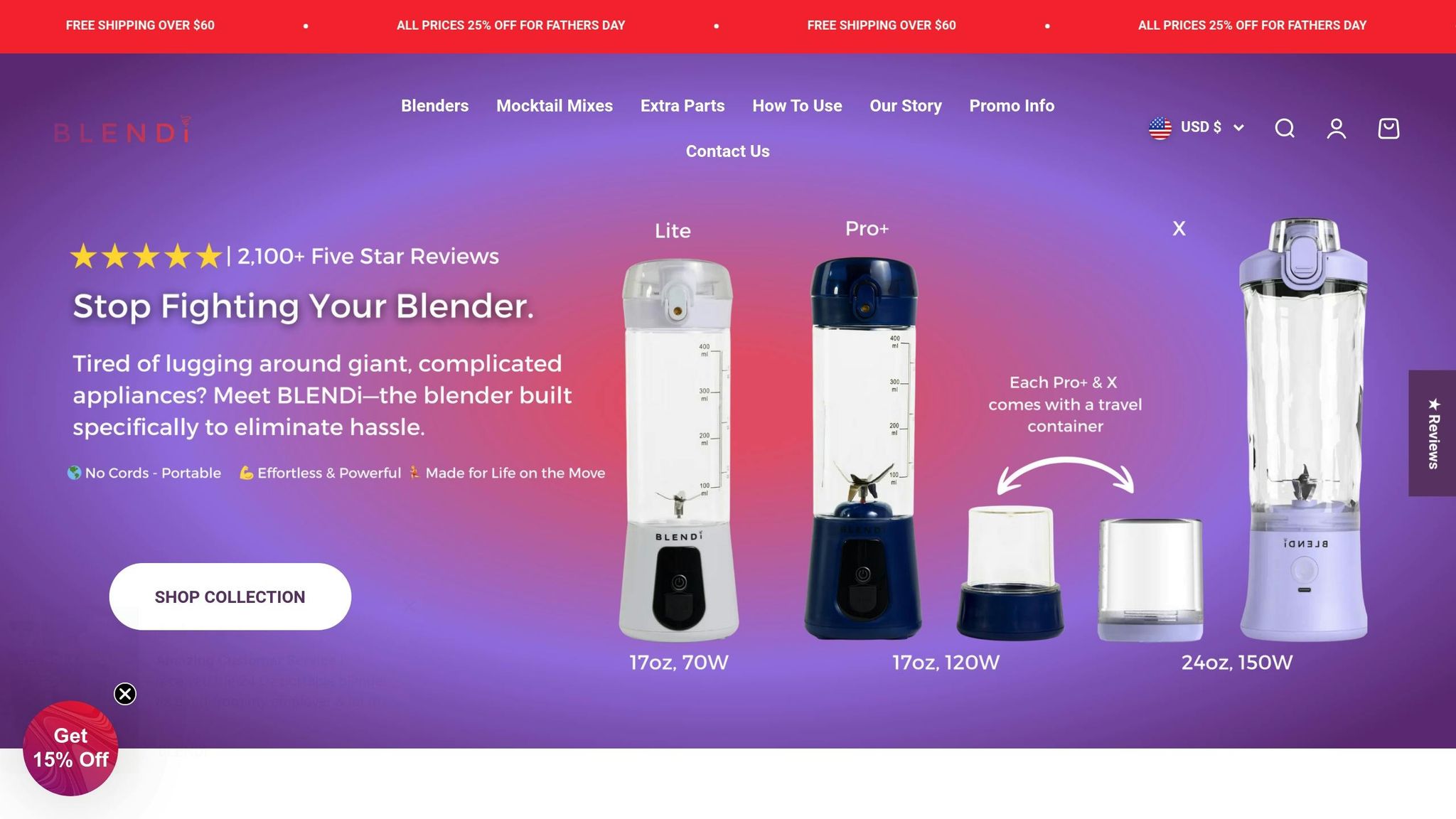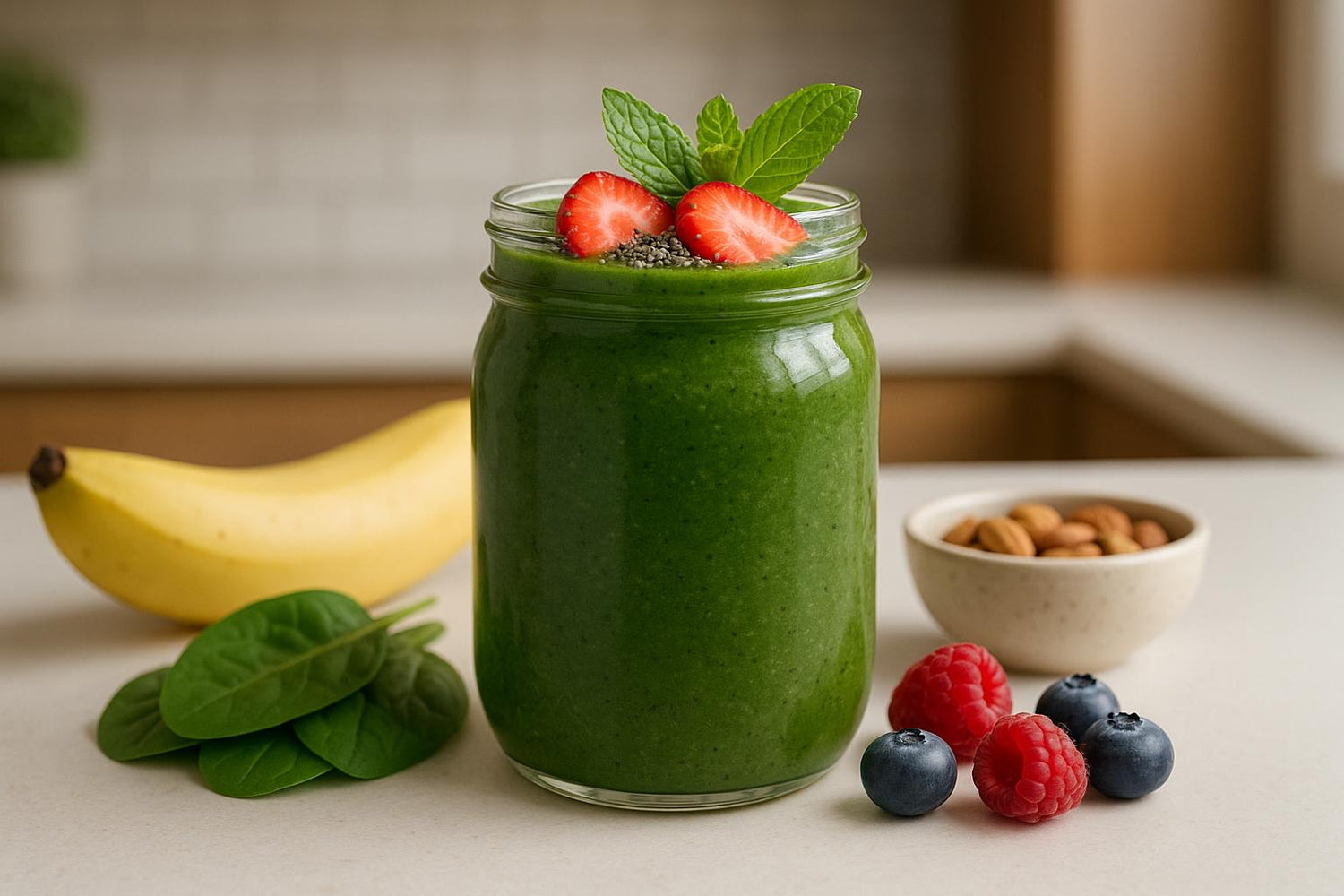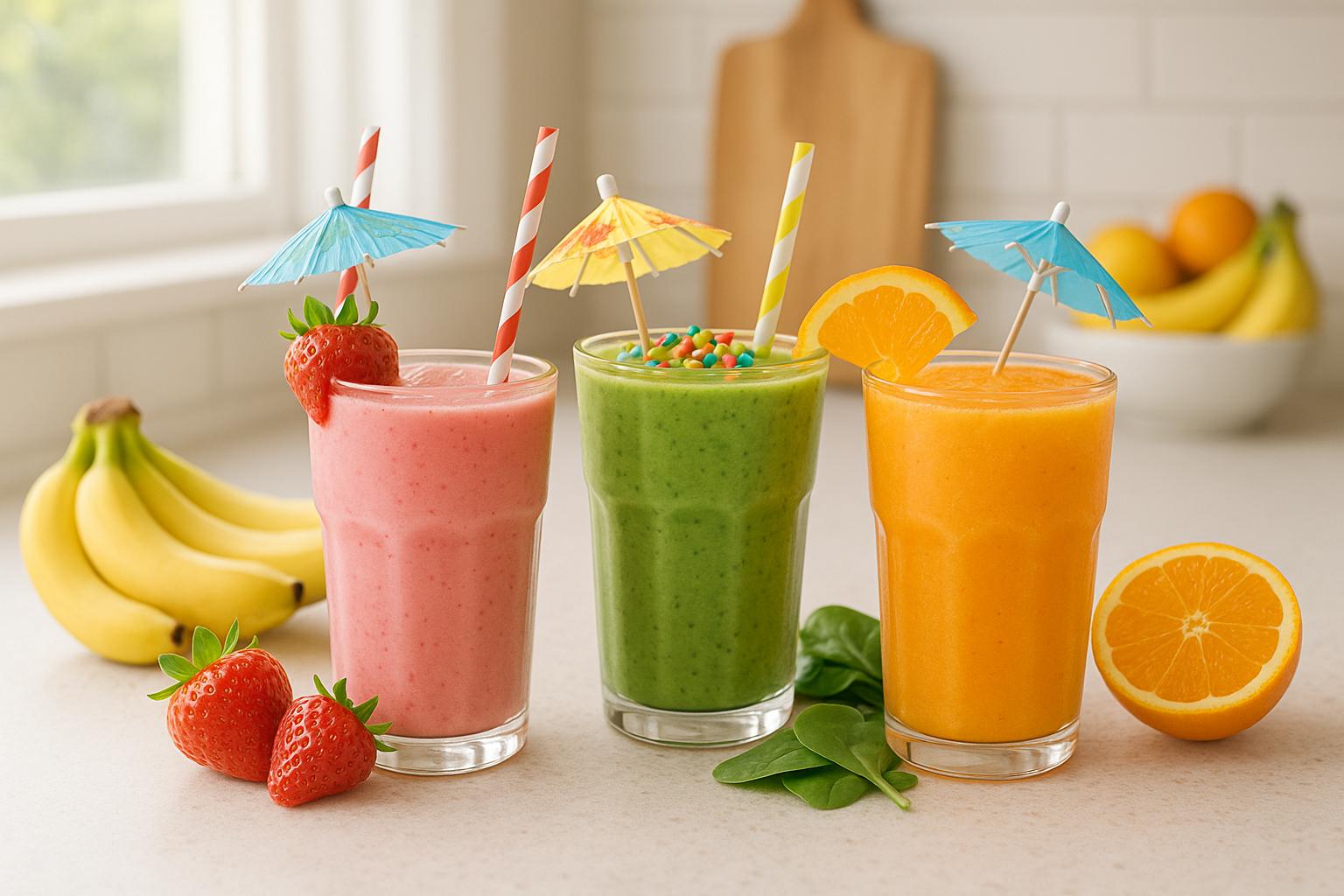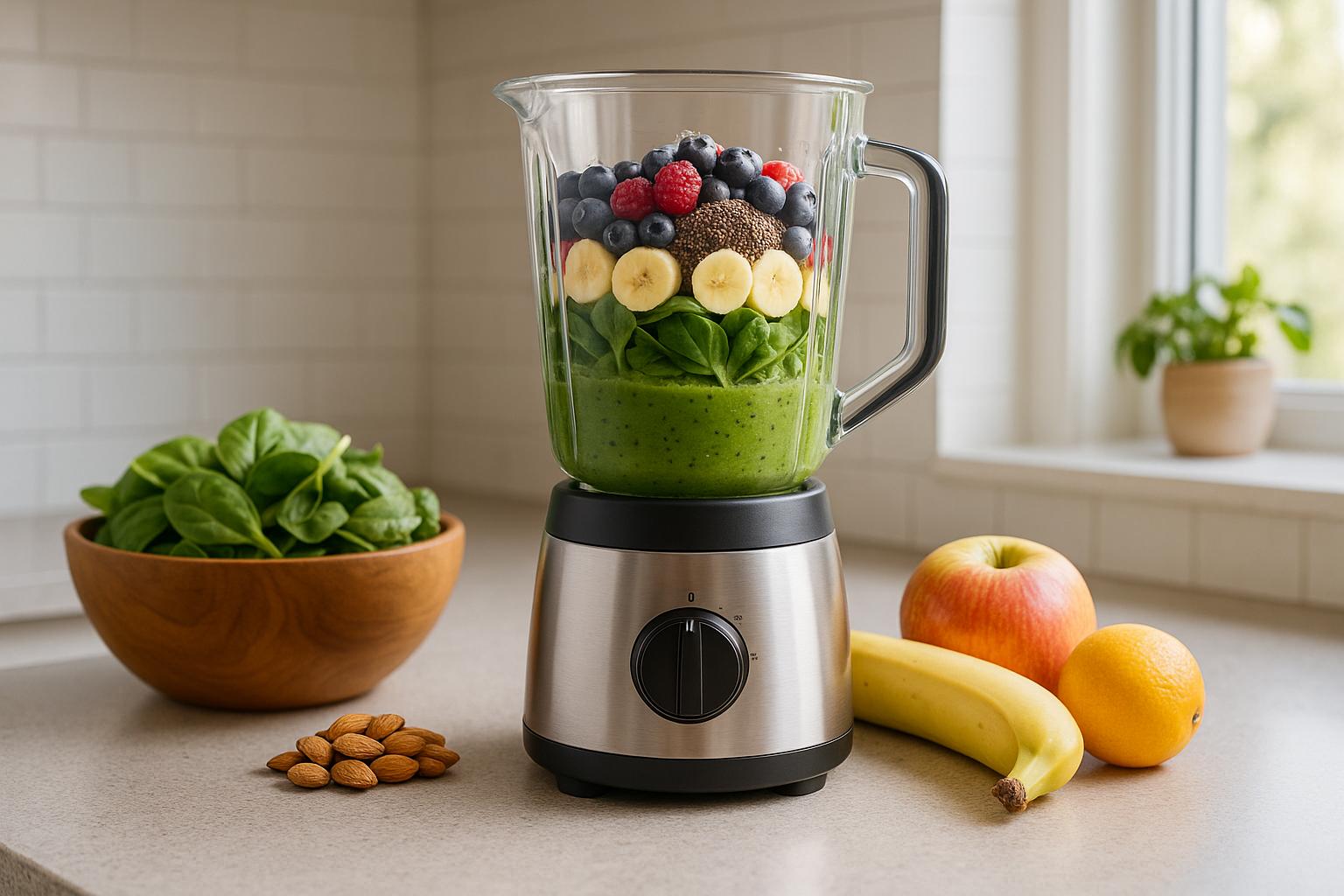Want to make healthier smoothies? Here’s what you need to know: Smoothies are a quick, easy way to get essential vitamins, minerals, fiber, and protein into your diet. Start with a liquid base, add leafy greens, fruits, healthy fats, and protein for a balanced blend that keeps you full and energized. Include superfoods like chia seeds or spirulina for an extra nutrient boost. Prep ingredients ahead of time to save time, and try portable blenders for on-the-go convenience.
Quick Checklist:
- Liquid Base: Water, almond milk, or coconut water (1 cup)
- Leafy Greens: Spinach or kale (1 cup)
- Fruits: Berries, bananas, or mango (1.5 cups)
- Protein: Greek yogurt, protein powder, or nut butter (15–30g)
- Healthy Fats: Avocado, chia seeds, or flaxseed (1–2 tbsp)
- Optional Add-ins: Ginger, turmeric, or frozen cubes for flavor
Smoothies are versatile and easy to customize. Whether for breakfast, post-workout, or a snack, they’re a great way to hit your nutrition goals.
5 HEALTHY SMOOTHIES | recipes for wellness and weight loss
Key Ingredients for Balanced Nutrition
Creating a nutrient-packed smoothie starts with understanding how each ingredient contributes to your health. By thoughtfully selecting ingredients, you can build a blend that fuels your body and supports overall well-being. Let’s break down the key components of a balanced smoothie and their benefits.
Fruits for Vitamins and Antioxidants
Fruits are a cornerstone of any smoothie, offering vital vitamins and powerful antioxidants. Berries, for instance, are antioxidant powerhouses. Blueberries top the list with 9 millimoles of antioxidants per 3.5-ounce serving, closely followed by pomegranates. Tart cherries provide 7 mmol, blackberries deliver 6 mmol, and both goji berries and raspberries contribute 4 mmol per serving.
Tropical fruits bring their own perks. Mangoes are rich in vitamin C, beta-carotene, and vitamin A, while bananas supply potassium and fiber. Kiwifruit is another standout, loaded with vitamin C, plus vitamin K, copper, vitamin E, fiber, potassium, and folate. Pineapples not only offer vitamin C and manganese but also bromelain, an enzyme that supports digestion.
Citrus fruits and apples shouldn’t be overlooked. Lemons and limes are packed with vitamin C and antioxidants, while apples provide fiber, vitamin C, and phytonutrients with antioxidant properties.
As dietitian Jordan Spivak from Sibley Memorial Hospital points out:
"Each fruit or vegetable offers something unique in terms of nutrients, so feel free to mix them up and get variety in your smoothie".
Leafy Greens and Vegetables for Micronutrients
Adding leafy greens transforms your smoothie into a nutrient-dense drink brimming with essential vitamins and minerals. Spinach is a popular choice for beginners, thanks to its mild flavor and easy blending. Kale offers even more nutrients but comes with a slightly bitter taste that pairs well with sweet fruits like mango or pineapple. Swiss chard has an earthy flavor, while collard greens are mild and work well with sweet ingredients.
Vegetables like carrots, beetroot, cucumber, and even cauliflower can further enhance the nutrient profile of your smoothie. These additions also help you meet the daily fiber intake goal of 25 to 38 grams, a target many Americans fall short of, averaging just 16 grams daily.
A diet rich in leafy greens has been linked to reduced risks of obesity, heart disease, high blood pressure, and cognitive decline. Plus, rotating different greens keeps things interesting and supports gut health.
Healthy Fats for Sustained Energy
Including healthy fats in your smoothie not only keeps you full longer but also helps your body absorb vitamins like A, D, E, and K. Nuts and seeds - such as almonds, walnuts, chia seeds, hemp seeds, and ground flaxseed - are excellent options. Nut butters like almond, peanut, or cashew butter add creaminess while delivering essential fatty acids.
Avocado is a standout addition, offering monounsaturated fats, fiber, vitamin K, copper, folate, and an array of other nutrients. It also lends a creamy texture to smoothies, making them more satisfying without overpowering the flavor.
Healthy fats aren’t just about calories - they enhance the nutritional value of your entire blend.
Protein Sources for Muscle Repair
Protein is a must if you want your smoothie to double as a meal or a post-workout recovery drink. As Miranda Galati, MHSc, RD, explains:
"It is healthy to add protein to smoothies because it helps balance blood sugar. When you pair a delicious fruit smoothie with protein, you'll benefit from more stable energy levels, a balanced snack that keeps you full for longer, and better gains in the gym".
Greek yogurt is a protein-packed favorite, offering 13 grams of protein per half-cup of non-fat yogurt. Cottage cheese is another excellent option, with 15 grams of protein in the same serving size. For plant-based diets, protein powders can deliver anywhere from 15 to 42 grams per serving.
Nut butters also contribute protein, with two tablespoons of peanut butter adding up to 8 grams. Milk options like 2% cow’s milk, soy milk, and pea milk provide over 8 grams of protein per cup, making them great liquid bases for your smoothie.
Jordan Spivak emphasizes the importance of protein:
"Protein builds and maintains muscle mass, and can help to keep you feeling full and satisfied".
Aim for 15 to 30 grams of protein per smoothie, depending on whether it’s a snack or meal replacement.
Superfoods and Boosters for Extra Nutrition
To take your smoothie to the next level, consider adding superfoods and boosters. These small but powerful ingredients can significantly enhance your blend’s nutrient profile. Chia seeds and ground flaxseed, for example, provide omega-3 fatty acids, fiber, and protein. Chia seeds also create a pudding-like texture when they absorb liquid.
Spirulina, a blue-green algae, delivers complete protein and B vitamins while giving your smoothie a vibrant color. Turmeric offers anti-inflammatory properties, and fresh ginger aids digestion while adding a spicy kick. These boosters may seem minor, but their nutritional impact is anything but.
Start small - a teaspoon of spirulina or a half-inch piece of fresh ginger is more than enough for beginners. You can always adjust the amounts as your palate gets used to these bold flavors.
Step-by-Step Smoothie Building Checklist
Here’s a simple guide to help you create a balanced, nutrient-packed smoothie.
Step 1: Choose a Liquid Base
Start with a liquid that sets the tone for your smoothie’s texture, flavor, and nutrition. Water is the easiest choice - calorie-free, hydrating, and neutral, so it won’t interfere with other flavors. If you’re looking for something more, consider your nutritional needs:
- Coconut water: Packed with natural electrolytes, about 45–60 calories per cup.
- Unsweetened almond milk: Creamy and light, with just 30–40 calories per cup.
- Oat milk: Adds 2–3 grams of fiber per serving.
- Soy milk: A protein powerhouse, delivering up to 9 grams per cup.
As registered dietitian Jamie N explains:
"The best liquid option for your smoothie is the one that you enjoy and makes sense for you nutritionally".
Use about 1 cup for a single serving, adjusting as needed for consistency. Once you’ve got your base, it’s time to add some greens.
Step 2: Add Leafy Greens or Vegetables
Boost your smoothie’s nutrients by tossing in about 1 cup of greens per serving. Aim for a 60/40 ratio - greens to fruit - for a balanced flavor. Spinach is a great starting point because of its mild taste, while kale offers a nutrient boost and pairs well with tropical fruits. You can also experiment with vegetables like carrots, cucumber, or zucchini for an extra layer of nutrients. Next, bring in the fruit.
Step 3: Include Fruits for Natural Sweetness
Fruits add natural sweetness and essential nutrients. Stick to about 1.5 cups of fruit per serving, and if you’re doubling up, use a 2:2:3 ratio (greens:liquid:fruit). Frozen fruits are a fantastic choice - they make your smoothie thick and creamy without needing ice. Popular options include:
- Bananas: Creamy texture and a good source of potassium.
- Berries: Packed with antioxidants.
- Tropical fruits like mango or pineapple: Perfect for masking the slightly bitter taste of greens like kale.
Now it’s time to add some protein and healthy fats.
Step 4: Add Healthy Fats and Protein
To keep you feeling full and energized, include 20–30 grams of protein and 1–2 tablespoons of healthy fats. Options like Greek yogurt or protein powder can meet your protein needs, while nut butter, avocado, or chia seeds provide the healthy fats. Chia seeds are particularly nutrient-dense, offering about 5 grams of protein, 10 grams of fiber, and 5 grams of omega-3s in just 1–2 tablespoons.
Food science professor Mario Ferruzzi from Purdue University highlights the importance of combining these elements:
"If you want to utilize more from your fruits and vegetables, you have to pair them correctly with fat-based dressings".
Finally, let’s talk about optional add-ins.
Step 5: Optional Add-Ins and Ice
Take your smoothie to the next level with superfoods and creative ice alternatives. Start small - add one superfood at a time to avoid overwhelming the flavor.
| Optional Add-In | Benefits | Recommended Amount |
|---|---|---|
| Chia Seeds | Protein, fiber, omega-3s, thickening | 1–2 tablespoons |
| Spirulina | Iron, complete protein, B vitamins | 1 tablespoon |
| Camu Camu Powder | Vitamin C (100%+ daily needs) | 1 teaspoon |
| Ground Flaxseed | Omega-3s and fiber | 1 tablespoon |
| Medjool Dates | Natural sweetness, fiber, potassium | 1–2 dates |
For a chilled smoothie, try frozen coconut water cubes for extra electrolytes, frozen coffee cubes for a caffeine kick, or chilled herbal tea for a flavor boost without watering it down.
Registered dietitian Rhyan Geiger sums it up perfectly:
"Together, protein, fiber, and fat help keep you full for longer while [supporting] muscle and brain health".
sbb-itb-75eb6cf
Tips for Maximizing Nutrient Content
To get the most out of your smoothies, it's not just about choosing the right ingredients. These tips can help ensure you're getting maximum nutrition in every sip.
Rotate Ingredients for a Broader Nutrient Profile
Mixing up your ingredients is key to getting a variety of nutrients. For example, switching between different leafy greens can help you avoid the buildup of certain substances. A good strategy is to use two types of greens (like spinach and kale) for one week, then switch to two others (such as romaine and Swiss chard) the next. You can also try mixing several greens in a single smoothie or rotating a different green each day. The same goes for fruits - alternate between berries, tropical fruits, and others to expand your intake of vitamins and minerals.
Prep Ingredients for Easy Assembly
Prepping ingredients ahead of time makes smoothie-making a breeze. Jessica from How Sweet Eats highlights the convenience factor:
"I found myself not even wanting to make the smoothie, which is so simple to begin with(!) because I dreaded getting everything out".
To streamline the process, create smoothie packs by combining fruits, greens, and dry ingredients in freezer-safe bags or jars. You can also pre-portion items like chia seeds, hemp seeds, or protein powder into small bags for single-use convenience. When it's time to blend, just add the contents to your blender along with your liquid of choice. For extra ease, consider freezing pre-blended smoothies in ice cube trays or mason jars. Just remember to leave space in jars for expansion when freezing. These packs and pre-blended options can last in the freezer for up to three months. As Laura Denby from Taste of Home puts it:
"Meal prep smoothies are a lifesaver".
By washing, cutting, and portioning ingredients ahead of time, you'll be more likely to stick to your smoothie routine and hit your nutritional goals.
Keep Portion Sizes in Check
Even the healthiest smoothie can derail your goals if portion sizes are too large. A good rule of thumb is to aim for around 250–300 mL (just over a cup) per serving. Use measuring cups or a food scale to ensure accuracy. To create a balanced meal, include a mix of protein, fruits and vegetables, and a healthy fat. This approach ensures you're getting a well-rounded nutrient profile without overloading on any one macronutrient.
Portable Blending Solutions for On-the-Go Nutrition
Who says you need to be in your kitchen to enjoy a nutrient-packed smoothie? Whether you're dashing to work, heading to the gym, or traveling, having a portable blender ensures you can stick to your healthy habits wherever life takes you. The right blender combines convenience and performance, so you never have to compromise on the quality of your smoothies.
Features of BLENDi Portable Blenders

BLENDi has developed three models to cater to a variety of blending needs:
- BLENDi Lite: Priced at $29.99, this 17 oz blender with a 70W motor is perfect for basic smoothies and protein shakes.
- Pro+ Model: At $59.99, it features a 120W motor capable of crushing ice and converts into a travel bottle for added versatility.
- BLENDi X: For $79.99, this model offers a 24 oz BPA-free bottle, a 150W motor, and dual blending modes for more advanced blending tasks.
All models are cordless and USB rechargeable, making them ideal for blending on the go. Select models, like the Pro+ and BLENDi X, even come with ice-crushing capabilities, ensuring you can enjoy refreshing smoothies anywhere.
Customers have praised these blenders for their performance and ease of use. Stacey Aguilar, for instance, shared her enthusiasm, stating:
"BLENDi is the best portable blender."
To enhance safety, BLENDi models include an LED indicator that signals when the blender is properly sealed (green) or unsealed (red). This feature was a deciding factor for Amazon customer Shawnte C., who upgraded to the BLENDi X in March 2025.
Portability and Convenience
Designed for busy lifestyles, portable blenders are compact and lightweight, making them easy to slip into a gym bag, backpack, or even a car cup holder. Their detachable cups double as both blending jars and drinking containers, cutting down on the number of items you need to carry.
Real-life usage examples highlight their practicality. In June 2025, Camille Heilig shared how she prepped her shake ingredients the night before and blended them fresh at work. Her BLENDi handled everything from berries and bananas to protein powder, almond milk, and peanut powder with ease.
These blenders are also incredibly efficient, whipping up smoothies or protein shakes in under a minute - perfect for busy mornings or post-workout nutrition. Cleaning is simple too, thanks to their minimal parts and self-cleaning features. As customer Janet Skillin noted:
"So easy to use and clean - no bulky machine on the counter."
Additional Accessories and Offerings
BLENDi provides a range of accessories to enhance your blending experience. The Pro+ model, for example, includes a premium storage case, USB-C charging cable, detachable wrist strap, and an extra blade cover - making it a complete travel solution.
For those wanting more variety, BLENDi offers Skinny Mocktail Mixers at $24.99 for a 6-pack. These zero-calorie, zero-sugar drink mixes are vegan and keto-friendly. You can also purchase spare parts for all models, starting at just $2.00, ensuring you're always prepared. Other accessories include a 16 oz Water Bottle Handler with a carrying strap for $9.99 and a Recipe Book featuring 99 healthy and delicious recipes in PDF format for $19.99 - perfect for smoothie inspiration.
BLENDi’s customer service further adds to their appeal. In June 2025, Joy Mathis shared her experience when her BLENDi stopped working after six months. The company promptly provided a free replacement with free shipping, leaving her impressed.
Conclusion: Building Better Smoothies for a Healthier You
Creating a nutrient-packed smoothie doesn’t have to be complicated. Start with a quality liquid base, toss in some greens and fruits, and round it out with protein and healthy fats to keep you feeling satisfied. As dietitian Jordan Spivak from Sibley Memorial Hospital puts it:
"When you make your own at home with ingredients that meet your nutrition needs and taste preferences, smoothies are a great way to get protein, fiber and other nutrients."
Smoothies are incredibly flexible. Whether you need a quick breakfast, a post-workout recovery boost, or a midday snack, you can customize each blend to suit your nutritional goals and flavor preferences.
Consistency starts with preparation. By prepping your ingredients ahead of time and keeping portion sizes in check, you’ll always be ready to whip up something healthy - even on your busiest days.
For those on the go, portable blending solutions make sticking to your routine easier than ever. BLENDi’s lineup, ranging from the compact Lite at $29.99 to the feature-packed BLENDi X at $79.99, ensures you can maintain your healthy habits no matter where life takes you. These tools remove the common barrier of being too busy or away from home to eat well.
Crystal Scott, M.S., RD, LDN, highlights the convenience and benefits:
"This means you can easily incorporate a range of vitamins, minerals, fiber and antioxidants into your diet in a convenient, easily digestible form."
FAQs
How can I make a smoothie that's both nutritious and keeps me energized all day?
To whip up a smoothie that’s both nourishing and keeps you fueled throughout the day, it’s all about balancing the right ingredients. Start with a solid protein base - think Greek yogurt, milk, or a plant-based alternative - to help curb hunger and keep you satisfied. Then, add a dose of healthy fats like almond butter, peanut butter, or seeds such as chia or flax to provide steady energy. For fiber and extra nutrients, toss in fresh or frozen fruits like berries or bananas, along with some leafy greens like spinach or kale.
When choosing a liquid base, go for unsweetened options like water, almond milk, or coconut water to steer clear of unnecessary sugars. If you’re always on the move, a portable blender like the BLENDi Lite or BLENDi Pro+ can make it super convenient to enjoy your smoothie anytime. The key is to strike the right balance of carbs, protein, and fats for energy that lasts.
What’s the best way to add superfoods to my smoothies without affecting the taste too much?
To incorporate superfoods into your smoothies without overwhelming the taste, start with small amounts - like a teaspoon of chia seeds, flaxseeds, or just a pinch of spirulina. As you get used to the flavors, you can gradually add more. Combining superfoods with naturally sweet options such as bananas, berries, or mango can help balance out stronger flavors while keeping your smoothie both tasty and packed with nutrients.
For a richer texture and added flavor, try mixing in healthy fats like avocado, almond butter, or Greek yogurt. These not only enhance the taste but also help your body absorb fat-soluble nutrients from the superfoods. Plus, using a portable blender like the BLENDi makes experimenting with your smoothie recipes easy, even when you're on the go!
What are the advantages of using a portable blender for making smoothies while on the go?
Portable blenders are a game-changer for anyone who loves fresh, nutrient-rich smoothies on the go. Their compact, lightweight design and cordless functionality mean you can whip up your favorite drinks at the office, the gym, or even while traveling. No more skipping healthy options just because you're short on time or away from home.
Many models come equipped with features like ice-crushing power and various blending modes, making it easy to customize your drinks. These handy devices fit perfectly into busy lifestyles, offering convenience and versatility while keeping your nutrition goals on track.




Leave a comment
This site is protected by hCaptcha and the hCaptcha Privacy Policy and Terms of Service apply.